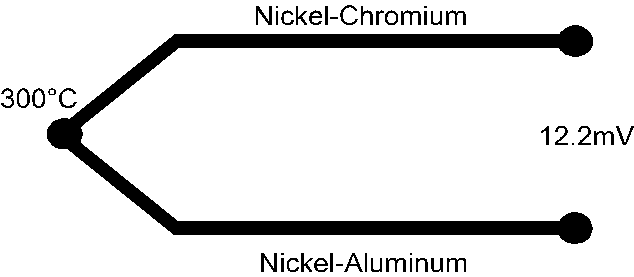Introduction to Thermocouples
Thermocouples are the most popular kind of temperature sensor. They consist of two different metallic wires, e.g., one chromel and one constantan, coupled at the probe tip (i.e., a measurement junction) and extended to the reference (i.e., “temperature”) junction. A thermocouple consists of two wires made of dissimilar metals and welded at one end. This junction  is called the hot or measuring junction. The other junction is called the cold or reference junction and is connected to the output device (voltmeter, temperature indicator).
is called the hot or measuring junction. The other junction is called the cold or reference junction and is connected to the output device (voltmeter, temperature indicator).
The temperature difference between the probe tip and the reference junction is detected by measuring the change in voltage (electromotive force, EMF) at the reference junction. The junction between two metals generates a voltage which is a function of temperature. Thermocouples rely on this Seebeck effect. Almost any two types of metal can be used to make a thermocouple.
The absolute temperature reading can then be obtained by combining the information of the known reference temperature and the difference of temperature between the probe tip and the reference.
 For practical purposes, it is important to designate each of the junctions. The measuring junction (often referred to as the "hot" junction) is that which is exposed to measured temperature. The reference junction is the other junction, and is that which is kept at a known temperature; it is often referred to as the "cold" junction. The term “thermocouple” refers to a complete system for producing thermal voltages and generally implies an actual assembly (e.g., a sheathed device with extension leads or a terminal block.) The two conductors and their associated measuring junction constitute a thermo element and the individual conductors are identified as the positive or negative leg.
For practical purposes, it is important to designate each of the junctions. The measuring junction (often referred to as the "hot" junction) is that which is exposed to measured temperature. The reference junction is the other junction, and is that which is kept at a known temperature; it is often referred to as the "cold" junction. The term “thermocouple” refers to a complete system for producing thermal voltages and generally implies an actual assembly (e.g., a sheathed device with extension leads or a terminal block.) The two conductors and their associated measuring junction constitute a thermo element and the individual conductors are identified as the positive or negative leg.
Principle of Operation
There are three major effects involved in a thermocouple circuit: the Seebeck, Peltier, and Thomson effects.
Seebeck Effect
The Seebeck effect describes the voltage or electromotive force (EMF) induced by the temperature difference (gradient) along the wire. The change in material EMF with respect to a change in temperature is called the Seebeck coefficient or thermoelectric sensitivity. This coefficient is usually a nonlinear function of temperature.
Peltier effect
The Peltier effect describes the temperature difference generated by EMF and is the reverse of the Seebeck effect.
Thomson effects:
Finally, the Thomson effect relates the reversible thermal gradient and EMF in a homogeneous conductor. In the Thomson effect, heat is absorbed or produced when current flows in a material with a temperature gradient. The heat is proportional to both the electric current and the temperature gradient. This proportionality constant, known as the Thomson coefficient, is related in thermodynamics to the Seebeck coefficient.
Advantages and Disadvantages of Thermocouples
• Thermocouples allow measurement of temperatures higher than that possible with resistance devices (RTDs) like the platinum resistance thermometer. Their operating range is far wider: compare -200 to 650°C for platinum probes with -200 to more than 2000 °C with refractory thermocouples.
• On the other hand, thermocouples are less accurate and less stable than RTDs and more subject to drift over time. They need to be checked and calibrated frequently.
• Heterogeneities in thermocouple wires induce parasitic emf in regions where temperature gradients exist. This leads to temperature measurement errors which can be a major limitation in using thermocouples to achieve highly accurate temperature measurements.
***
Want to know more about thermocouples? Click here to schedule a live session with an eAge eTutor!
About eAge Tutoring:
eAgeTutor.com is the premium online tutoring provider. Using materials developed by highly qualified educators and leading content developers, a team of top-notch software experts, and a group of passionate educators, eAgeTutor works to ensure the success and satisfaction of all of its students.
Contact us today to learn more about our guaranteed results and discuss how we can help make the dreams of the student in your life come true!